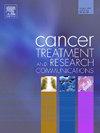多个新辅助化疗周期对晚期上皮性卵巢癌患者的影响:单中心经验
IF 2.4
Q3 Medicine
引用次数: 0
摘要
在间隔减积手术前进行三到四个周期的新辅助化疗是卵巢癌的常见治疗方法。本研究旨在确定增加新辅助化疗周期对诊断为上皮性卵巢癌患者的总生存期、无进展生存期和疾病反应的影响。方法选取2010 - 2021年间在诺拉公主肿瘤中心和阿卜杜勒阿齐兹国王医疗城接受NACT治疗的晚期EOC患者28例,分为两组进行回顾性队列研究。第一组患者接受的NACT治疗周期少于6个,而第二组患者接受的NACT治疗周期为6个或更多。比较OS、PFS和NACT反应的差异。结果NACT治疗少于6个周期组患者的中位OS为22.50个月([IQR], 35.75个月),6个周期及以上组患者的中位OS为29.5个月(IQR, 28.75个月)(P = 0.67)。接受少于6个周期治疗组的中位PFS为12个月(IQR, 16),接受6个或更多周期治疗组的中位PFS为9个月(IQR, 21.5个月)(P = 0.88)。接受NACT治疗少于6个周期的组中有6名患者和接受6个或更多周期NACT治疗的组中有5名患者对治疗完全缓解(P = 0.81)。结论:增加NACT周期对OS、PFS或对治疗的总体反应没有显著影响。然而,该研究的小患者群体存在局限性。本文章由计算机程序翻译,如有差异,请以英文原文为准。
The impact of multiple neoadjuvant chemotherapy cycles in patients with advanced epithelial ovarian cancer: A single center experience
Aim
Three to four cycles of neoadjuvant chemotherapy prior to interval debulking surgery is a common treatment of ovarian cancer. This study aimed to determine the impact of increasing the number of neoadjuvant chemotherapy cycles on overall survival), progression-free survival, and disease responses in patients diagnosed with epithelial ovarian cancer.
Methods
Twenty-eight patients who underwent NACT for advanced-stage EOC were enrolled in a retrospective cohort study conducted at Princess Noorah Oncology Center and King Abdulaziz Medical City between 2010 and 2021 and divided into two groups. Patients in the first group received fewer than six cycles of NACT while those the second group were treated with six or more cycles. Differences in the OS, PFS, and NACT responses were compared.
Results
The median OS was 22.50 months ([IQR], 35.75 months) among patients in the group who received fewer than six cycles of NACT and 29.5 months (IQR, 28.75 months) for those treated with six cycles or more (P = 0.67). The median PFS was 12 months (IQR, 16) for the group that received fewer than six cycles, and nine months (IQR, 21.5 months) for patients assigned to the group that received six or more cycles (P = 0.88). Six of the patients from the group that received fewer than six cycles of NACT and five of the patients from the group that received six cycles or more achieved a complete response to therapy (P = 0.81).
Conclusion
Increasing the number of NACT cycles did not significantly impact OS, PFS, or the overall response to therapy. However, the study's small patient population presents a limitation.
求助全文
通过发布文献求助,成功后即可免费获取论文全文。
去求助
来源期刊

Cancer treatment and research communications
Medicine-Oncology
CiteScore
4.30
自引率
0.00%
发文量
148
审稿时长
56 days
期刊介绍:
Cancer Treatment and Research Communications is an international peer-reviewed publication dedicated to providing comprehensive basic, translational, and clinical oncology research. The journal is devoted to articles on detection, diagnosis, prevention, policy, and treatment of cancer and provides a global forum for the nurturing and development of future generations of oncology scientists. Cancer Treatment and Research Communications publishes comprehensive reviews and original studies describing various aspects of basic through clinical research of all tumor types. The journal also accepts clinical studies in oncology, with an emphasis on prospective early phase clinical trials. Specific areas of interest include basic, translational, and clinical research and mechanistic approaches; cancer biology; molecular carcinogenesis; genetics and genomics; stem cell and developmental biology; immunology; molecular and cellular oncology; systems biology; drug sensitivity and resistance; gene and antisense therapy; pathology, markers, and prognostic indicators; chemoprevention strategies; multimodality therapy; cancer policy; and integration of various approaches. Our mission is to be the premier source of relevant information through promoting excellence in research and facilitating the timely translation of that science to health care and clinical practice.
 求助内容:
求助内容: 应助结果提醒方式:
应助结果提醒方式:


